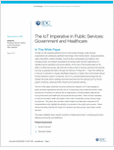 | Aging populations, rapid urbanization, political instability, concerns about sustainability and resiliency, and changing worker and resident expectations are driving public services organizations to radically improve operations and service delivery. At the core of this transformation is the ability to collect and process vast amounts of data to help to improve outcomes and services. One way to generate this data is through the Internet of Things (IoT) — which IDC defines as a network of networks of uniquely identifiable endpoints or "things" that communicate without human interaction using IP connectivity. The IoT is a transformational technology that can reshape the public sector, enabling improved outcomes and new services such as remote patient monitoring, advanced traffic solutions and predictive policing. This IDC white paper examines the drivers behind the adoption of IoT technologies by public services organizations and why the IoT is becoming a key investment priority. Public services are comprised of a diverse set of organizations, including federal, regional and local governments and healthcare and social services providers. These all have mandates to improve the safety, health and quality of life of their constituents across a broad range of programs. This paper also provides market insights and describes examples of IoT implementations that highlight the diversity of scenarios in the public service sector. These diverse scenarios illustrate the impact IoT solutions can have across many citizen-centric services. Request Free! |
